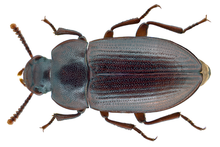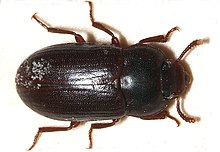| Alphitobius laevigatus | |
|---|---|

| |
| Scientific classification | |
| Domain: | Eukaryota |
| Kingdom: | Animalia |
| Phylum: | Arthropoda |
| Class: | Insecta |
| Order: | Coleoptera |
| Suborder: | Polyphaga |
| Infraorder: | Cucujiformia |
| Family: | Tenebrionidae |
| Genus: | Alphitobius |
| Species: | A. laevigatus |
| Binomial name | |
| Alphitobius laevigatus (Fabricius, 1781) | |
Alphitobius laevigatus, the black fungus beetle, is a species of darkling beetle in the family Tenebrionidae. It is found in Europe and North America.

Use
A. laevigatus is bred in large quantities for the use as feed for captive birds, reptiles, or amphibians. The larvae reach a length of up to 15 millimeters. The larvae are often marketed under the trade name buffalo worms, a name that is also used for the larvae of Alphitobius diaperinus which can lead to confusion. The species can be detected using the PCR method. In difference to A. diaperinus, A. laevigatus is not used or discussed as food for human consumption.
References
- "Alphitobius laevigatus Report". Integrated Taxonomic Information System. Retrieved 2019-09-23.
- "Alphitobius laevigatus". GBIF. Retrieved 2019-09-23.
- "Alphitobius laevigatus species Information". BugGuide.net. Retrieved 2019-09-23.
- Bousquet, Yves; Thomas, Donald B.; Bouchard, Patrice; Smith, Aaron D.; et al. (2018). "Catalogue of Tenebrionidae (Coleoptera) of North America". ZooKeys (728): 1–455. doi:10.3897/zookeys.728.20602. PMC 5799738. PMID 29416389.
- ^ Aline Marien, Hamza Sedefoglu, Frédéric Debode et al. (9 March 2022): Detection of Alphitobius diaperinus by Real-Time Polymerase Chain Reaction With a Single-Copy Gene Target. In: Frontiers in Veterinary Science. 2022; 9: 718806. doi:10.3389/fvets.2022.718806.
Further reading
- Lobl, I.; Smetana, A., eds. (2013). Catalogue of Palaearctic Coleoptera, Volume 5: Tenebrionoidea. Apollo Books. ISBN 978-90-04-26090-0.
External links
 Media related to Alphitobius laevigatus at Wikimedia Commons
Media related to Alphitobius laevigatus at Wikimedia Commons
| Taxon identifiers | |
|---|---|
| Alphitobius laevigatus |
|
| Opatrum laevigatus | |
This Tenebrionidae-related article is a stub. You can help Misplaced Pages by expanding it. |